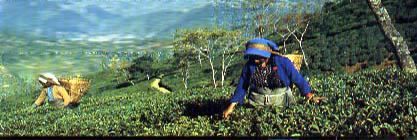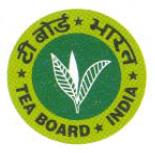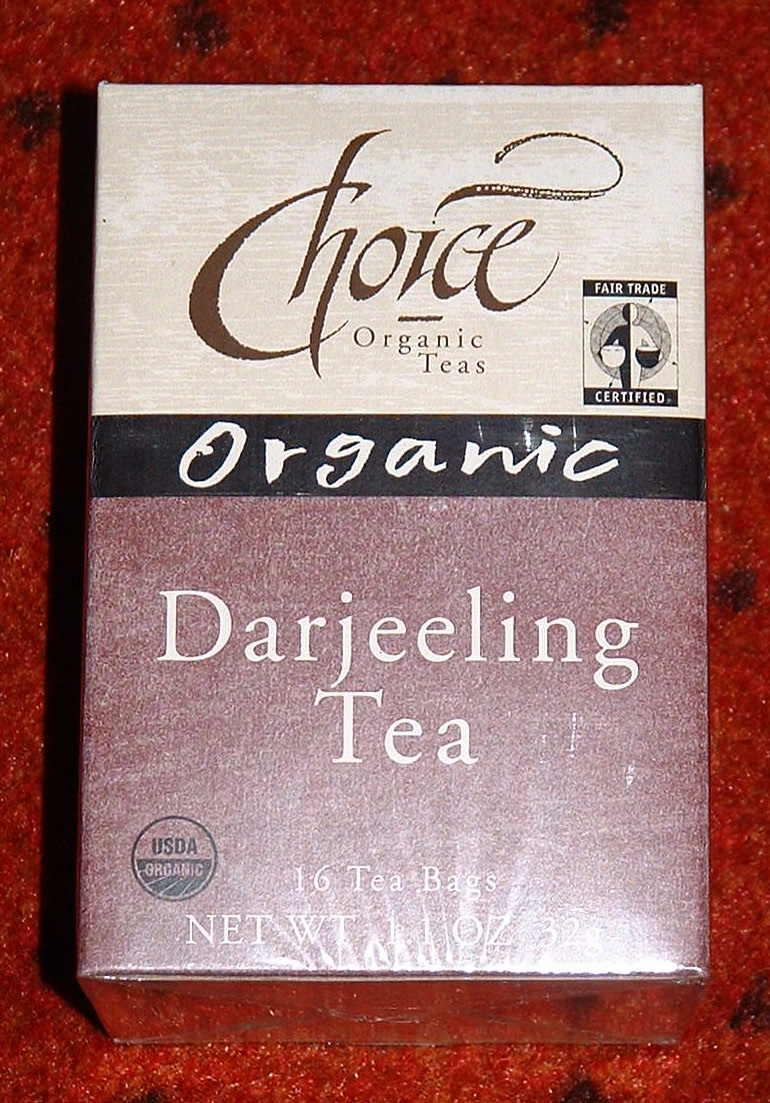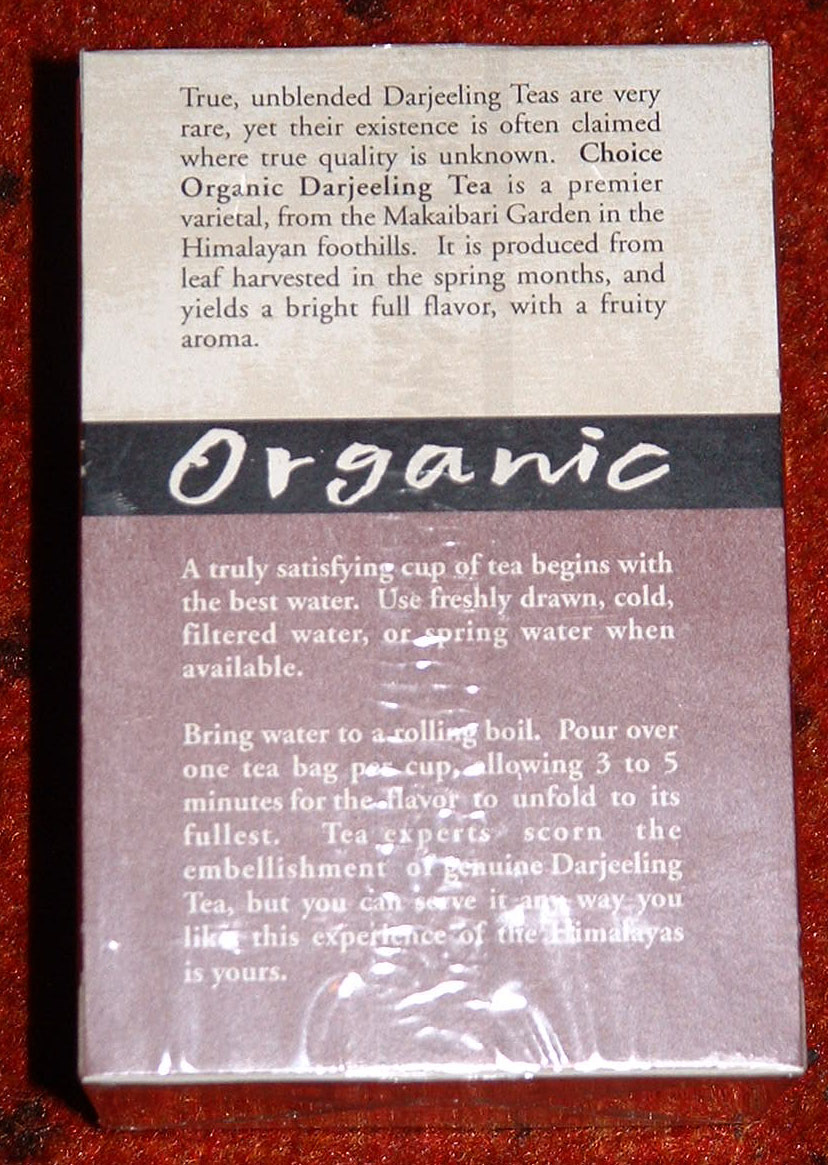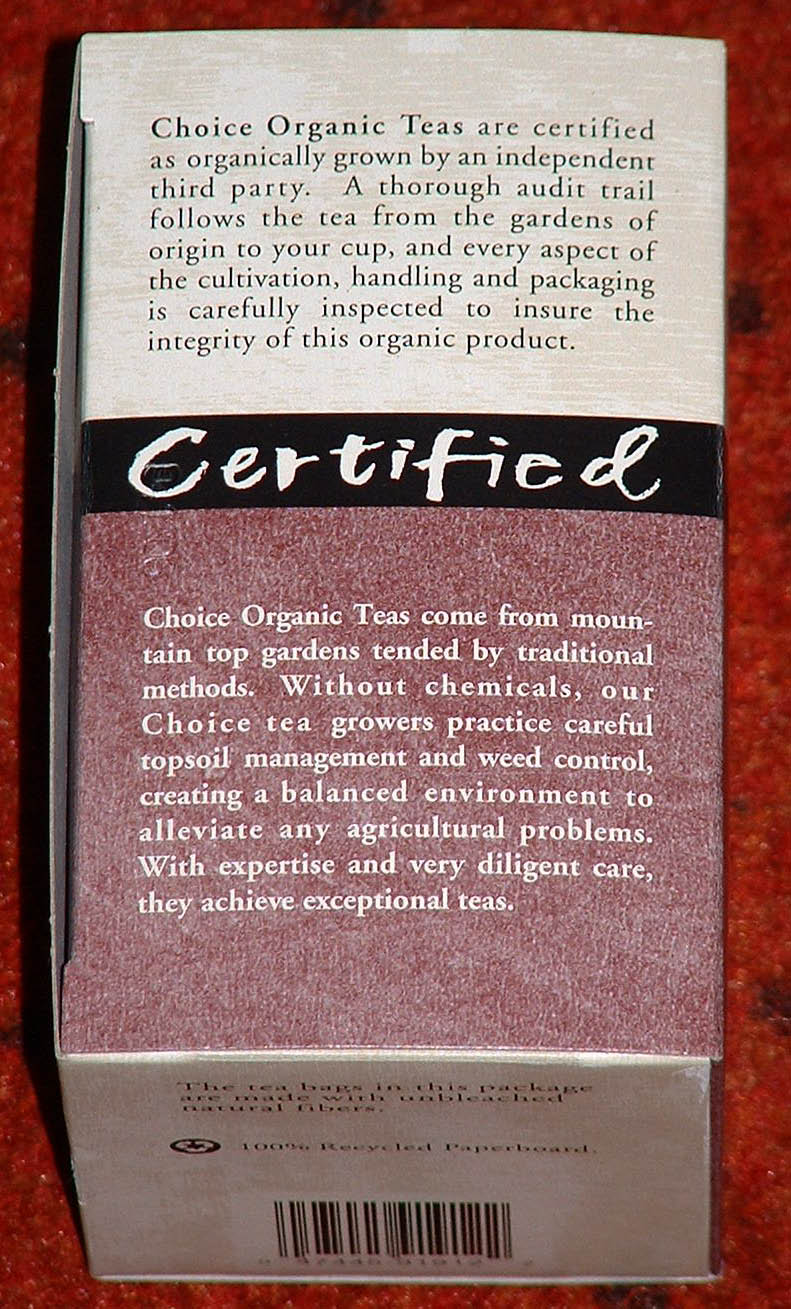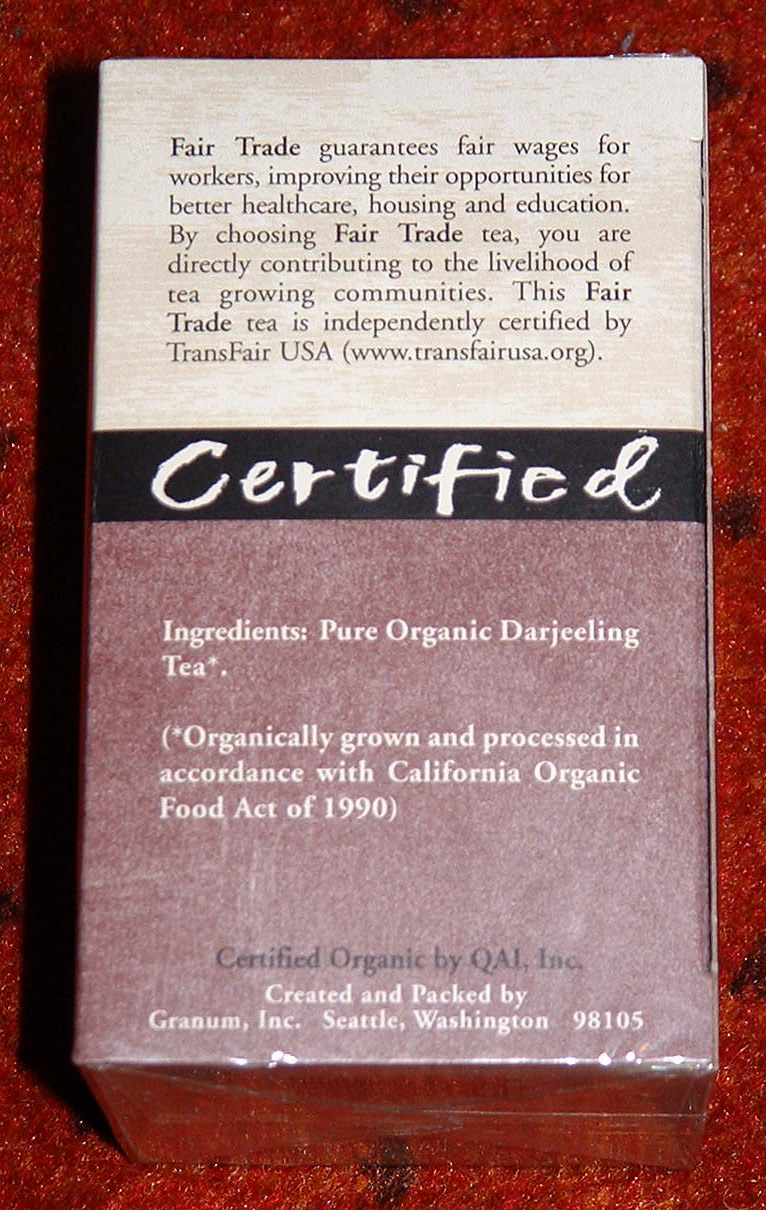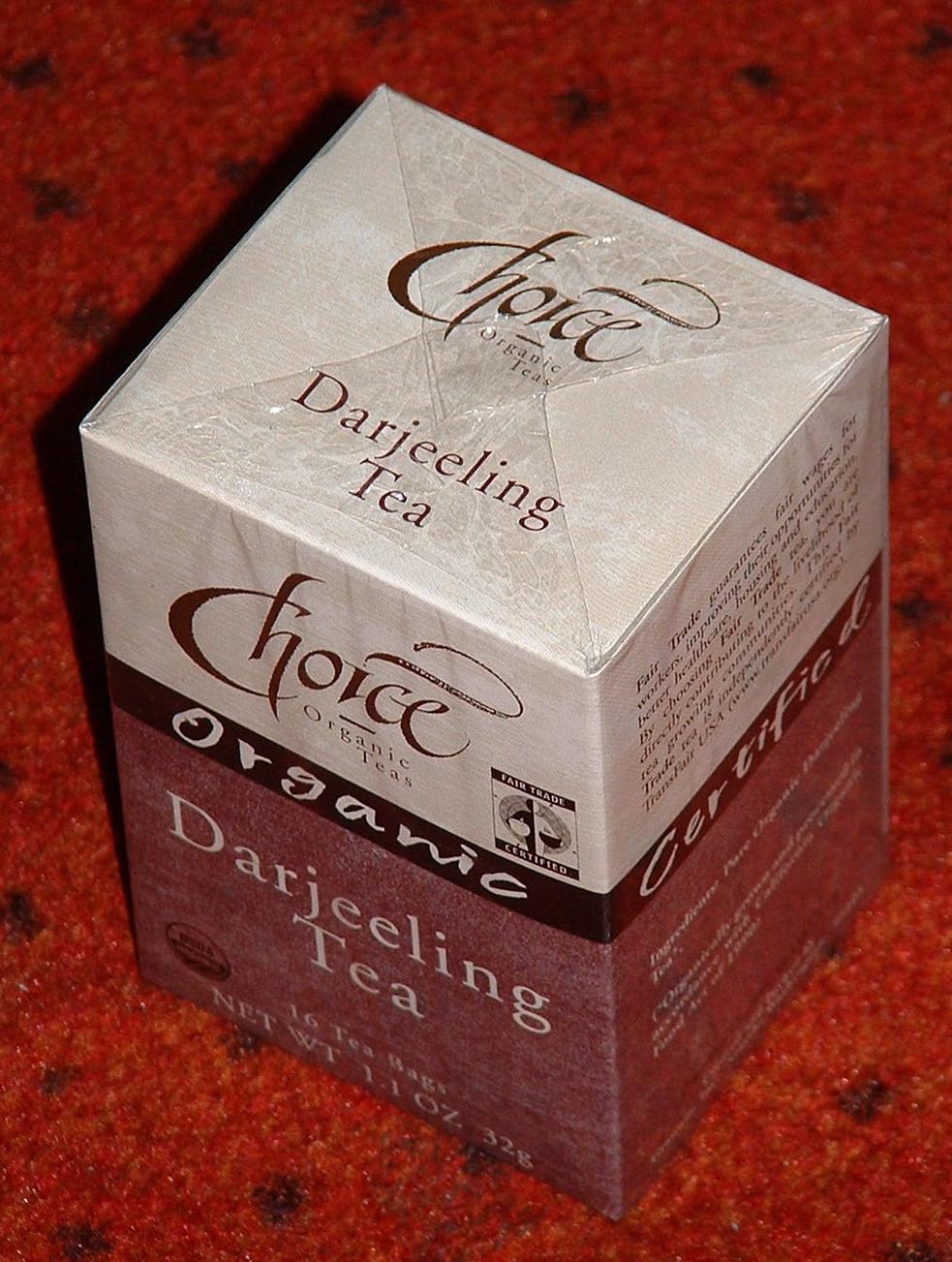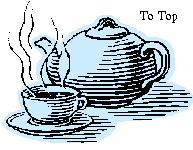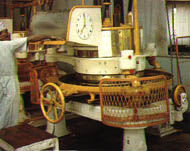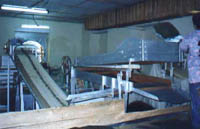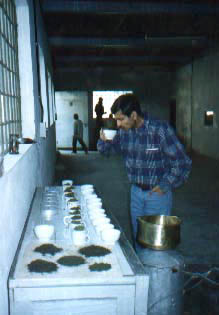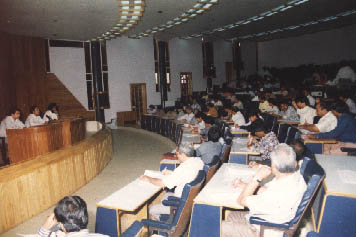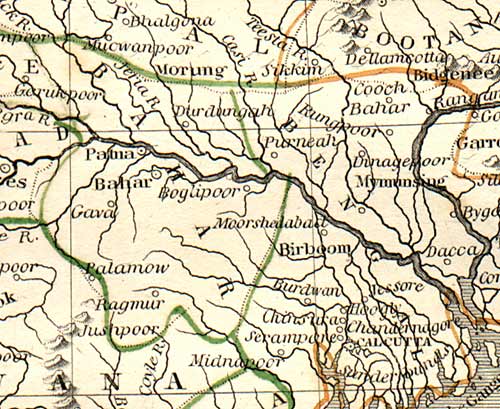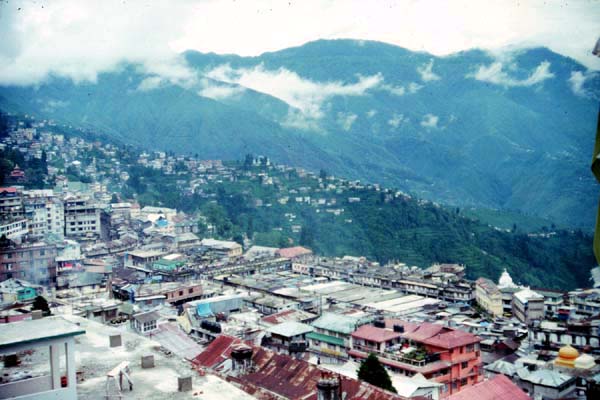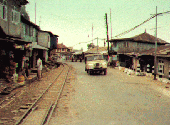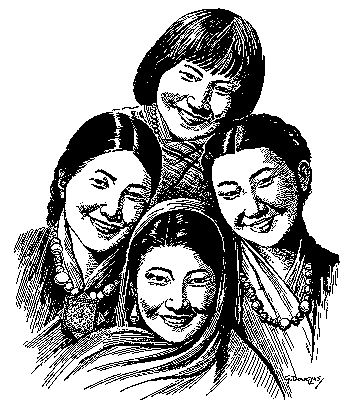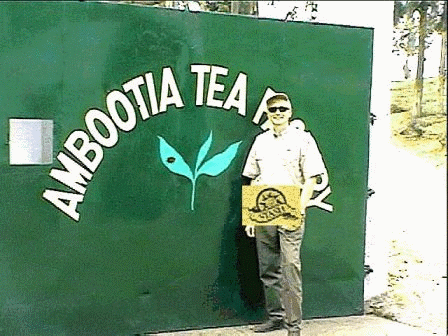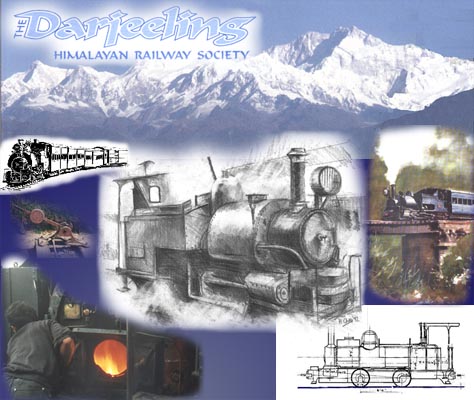| 1. |
The issue | 8. |
Trade |
|
||||
| 2. |
Description | 9. |
Environment | |||||
| 3.
|
History | 10 |
Culture | |||||
| 4. |
Association | 11. |
Related cases | |||||
| 5. |
Production | 12. |
Commercial | |||||
| 6. |
Legal | 13. |
Bibliography | |||||
| 7. |
Geography | 14. |
Links | |||||
Intelectual
Property Rights of Darjeeling Tea in the age of globalization
and world trade |
||||||||
| American University - Trade & Environment Database (TED) Journal, Number 752, July 2004 |
||||||||
1. The issue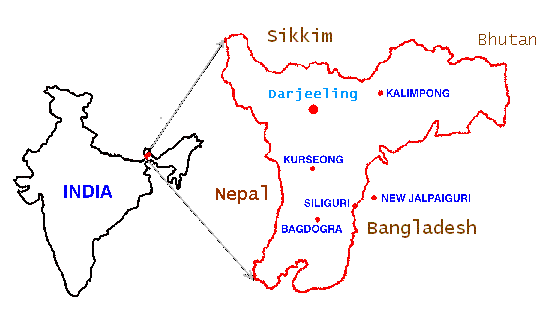
Darjeeling is a name of a region in north-east India (see map). Now, look at the pack of tea above. Press on each photo to read the advdertizments and signs which include:
-
"Choice Organic Darjeeling Tea is a premier varietal, from the Makaibari Garden in the Himalayan foothills."
-
"This experience of the Himalayas is yours."
-
"Choice Organic Teas come from mountain top gardens tended by traditional methods"
-
"Fair Trade guarantees fair wages to workers..."
-
"True, unblended Darjeeling Teas are very rare, yet their existence is often claimed where true quality is unknown."
-
A graphic symbol and text: "FAIR TRADE CERTIFIED" (on front side).
Surely they mean that the tea inside the package was actually grown in the Darjeeling area in the Himlayan foothills, don't they? Or do they mean that the tea plants which they use were originally imported from that area? A person in the supermarket looking for Darjeeling Tea from Darjeeling hills near the Himalayans would probably feel very confident that this package holds "the real thing". Not only is the package saying that it contains "Darjeeling Tea", but it also carries two very large "Certified" signs on both its sides and it makes you think, in so many other ways, that the tea inside was grown in Darjeeling near the Himalayas.
Note: The package and brand in the above photographs are used here only for the purpose of demonstrating a case: to show how companies go a long way to make their potential customers think that the package contains real Darjeeling Tea from Darjeeling, India, since there isn't quite anything like it in the world. Yet it is unclear if the tea was really grown there. The wording of the phrases and signs on the package lead us to think that the tea was grown and processed in Darjeeling, yet we didn't find a clear statement which assures us of that, and, on the other hand, the above package cost less than 3$ - which was the same price of other types of teas from the same series of teas sold in the supermarket; yet a real Darjeeling Tea grown in Darjeeling is usually more expensive than other teas, since it is chronically in higher demand than supply. Please read on and make your own judgement.
Kenyan coffee comes from Kenya, right? Congnac comes from the region of Cognac in France, right? And Darjeeling tea comes from the region of Darjeeling in India, on the footsteps of the Himalaya, right? Well, wrong! The name is often used to mislead consumers.
India alleges that Darjeeling produces only 10 million kgs tea but about 40 million kgs of 'Darjeeling tea' is available in the world market every year (Darjeelingnews.net) . That is why the Tea Board of India is taking steps to protect the name 'Darjeeling Tea' against erroneous use.
Under section 3 of Part II of the World Trade Organization (WTO) TRIPS Agreement, products which are shown to have special qualities which are related to a certain geographical region, are regarded as Geographical Indicators (GI) and are protected, internationally, by the TRIPS Agreement, which is signed by most countries in the World.
But, "it ain't necessarily so..". As this site shows and explains, the protection of Geographical Indicators is imposed only on Wines and Spirits so far. Products like Darjeeling Tea, Columbian Coffee etc., which are clearly associated with a specific geographical region, are still not acknoledged by the WTO to be Geographical Indicators according to the TRIPS agreement.
2.
Description
What
is Darjeeling Tea?
According to Darjeeling
Planters Association, "Darjeeling Tea is the World’s
most expensive and exotically flavoured tea. Connoisseurs will assert
that without Darjeeling, Tea would be like Wine without the prestige
of Champagne". 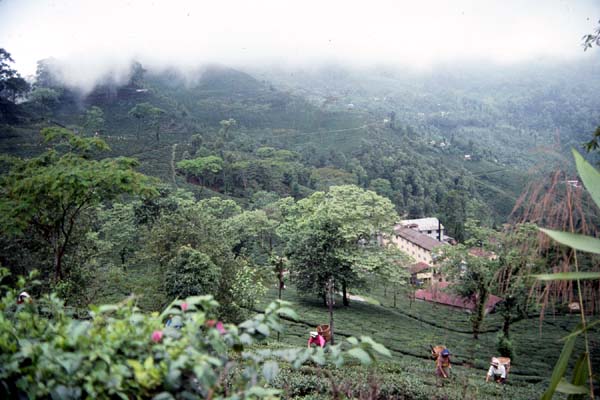
The Darjeeling Planters Association writes in its web site that according to the Tea Board Of India - "Darjeeling Tea" means:
-
tea which has been cultivated, grown, produced, manufactured and processed in tea gardens (current schedule whereof is attached hereto) in the hilly areas of Sadar Sub-Division, only hilly areas of Kalimpong Sub-Division comprising of Samabeong Tea Estate, Ambiok Tea Estate, Mission Hill Tea Estate and Kumai Tea Estate and Kurseong Sub-Division excluding the areas in jurisdiction list 20,21,23,24,29,31 and 33 comprising Subtiguri Sub-Division of New Chumta Tea Estate, Simulbari and Marionbari Tea Estate of Kurseong Police Station in Kurseong Sub-Division of the District of Darjeeling in the State of West Bengal, India.
-
tea which has been processed and manufactured in a factory located in the aforesaid area.
-
which, when brewed, has a distinctive, naturally occurring aroma and taste with light tea liquour and the infused leaf of which has a distinctive fragrance.
Present
Scenario
"Today
there are 86 running gardens producing ‘Darjeeling Tea’
on a total area of 19,000 hectares. The total production ranges from
10 to 11 million kgs annually.
"The Darjeeling tea industry at present employs over 52 thousand people on a permanent basis, while a further 15,000 persons are engaged during the plucking season which lasts from March to November. A unique feature of this work force is that more than 60 percent are women and the employment is on a family basis." (Darjeeling Planters Association)
3.
History
Did you know that Tea was grown in small family gardens for private
consumption in China for ages and that it reached India and Ceylon via
the British only in the 1800's?!
According
to In Pursuit of Tea, tea was first discovered in China around
2700 B.C. In 805 A.D. Tea was brought from China to 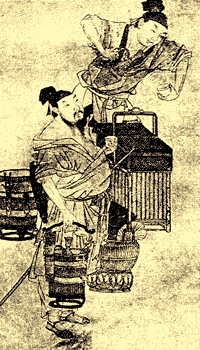 Japan
by a Buddhist monk. The Dutch and Portuguese brought tea to Europe around
1600. In 1689 traders with three hundred camels traveled 11,000 miles
to China and back in order to supply Russia’s demand. The trip
took sixteen months!
Japan
by a Buddhist monk. The Dutch and Portuguese brought tea to Europe around
1600. In 1689 traders with three hundred camels traveled 11,000 miles
to China and back in order to supply Russia’s demand. The trip
took sixteen months!
The demand for tea was very high in England, which started trading Opium for Tea with China in 1776.
In 1835 the East India company established experimental tea plantations in North-East India, in the region of Assam.
According
to the
Darjeeling Planters
Association,
"the story of Darjeeling Tea started around 1850 when a Dr. Campbell,
a civil surgeon, planted tea seeds in his garden at Beechwood, Darjeeling,
7000 ft above sea level as an experiment. He was reasonably successful
in raising the plant because the government, in 1847, elected to put
out tea nurseries in this area. 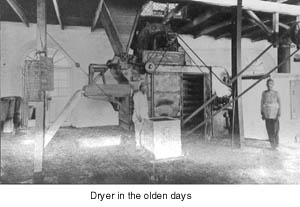
"According to records, the first commercial tea gardens planted out by the British tea interests were Tukvar, Steinthal and Aloobari tea estates. This was in 1852 and all these plantations used seeds that were raised in the government nurseries.
"Darjeeling was then only a sparsely populated hamlet which was being used as a hill resort by the army and some affluent people. Tea, being a labour intensive enterprise, required sufficient numbers of workers to plant, tend, pluck and finally manufacture the produce. For this, employment was offered to people from across the border of Nepal.
"It appears that in 1866, Darjeeling had 39 gardens producing a total crop of 21,000 kilograms of tea. In 1870, the number of gardens increased to 56 to produce about 71,000 kgs of tea harvested from 4,400 hectares. During 1860-64, the Darjeeling Company was established with 4 gardens while the Darjeeling Consolidated Tea Co. dates back to 1896. By 1874, tea in Darjeeling was found to be a profitable venture and there were 113 gardens with approximately 6,000 hectares."
Read
more on tea and it's long history at Wikipedia
(http://en.wikipedia.org/wiki/Tea).
A deed dated
Feb. 1, 1835 : |
||
The Governor- General having expressed his desire for the possession of the hill of Darjeeling on account of its cool climate I the said, Sikkimputtee Rajah, out of friendship for the said Governor-General, hereby present Darjeeling to The East India Company, that is, all the land South of the Great Ranjeet River, East of the Balsum, Khail and Little Ranjeet Rivers and West of Rungno and Mahanuddi Rivers. Dated
The 9th Maugh, Sambat 1891 AD, 1835 |
Source: Zubin.com: Darjeeling, the land and the people
4.
The Darjeeling Planters Association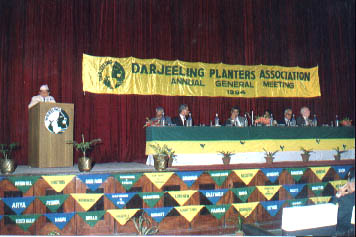
The
Very Beginning
"The First Annual General Meeting of the Darjeeling Planters was
held in 1873 to consult problems of the Darjeeling Tea Estates. Later
in 1892, the Darjeeling Planters Association (D.P.A.) was formed. The
association was affiliated to the Indian Tea Association (I.T.A.) in
1910.
"On 1st December, 1951, under the post Independence scenario, DPA in their last Extraordinary Meeting unanimously decided to dissolve the Association and transfer all its assets and liabilities to the newly formed Association called the Darjeeling Branch of the Indian Tea Association (D.B.I.T.A.). " (Darjeeling Planters Association)
The
Present Set-up 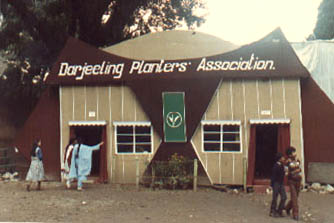
"Over the passage of time, the owner’s of Darjeeling Tea
Estates, considering its unique nature, special problems and attention
needed for the development, promotion and protection of Darjeeling Tea
– decided unanimously to form a sole independent Association to
address their common affairs.
"On 20th day of December, 1983 the present “DARJEELING PLANTERS ASSOCIATION” was formed under the chairmanship of Mr. S.K. Bhasin, dissolving D.B.I.T.A.
"Darjeeling
Planters Association, is one of the constituent member of the "Consultative
Committee of Plantation Associations" (CCPA) in India." (ibid)
5. The process of making, tasting and selling Darjeeling Tea
I.
The Art of Plucking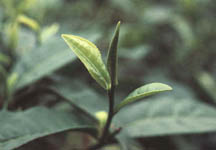
"Proper plucking of Darjeeling Tea leaves is as unique as its flavour.
Great emphasis is given to plucking as true quality is inherent in a
good raw material (Tea Leaf) and the special Darjeeling flavours is
generated from the very fine plucking standard. The smallest shoots,
comprising of two leaves and a bud are plucked. It requires 22,000 such
shoots, all plucked by hand - to produce 1 Kg. of Tea. In attaining
this high plucking standard, the hilly terrain, makes the task even
more difficult.
"Darjeeling
Tea Pluckers have strived hard for years, battling against difficult
terrain, cold, mist, rainfall etc. to maintain exacting standards. They
begin early in the morning, when the overnight dew is still present.
Only the tenderest leaves are finely plucked by gentle hands. Pluckers
are so quick and skilful that it is often impossible to follow the motion
of their hands and fingers as they pluck." (Darjeeling
Planters Association)
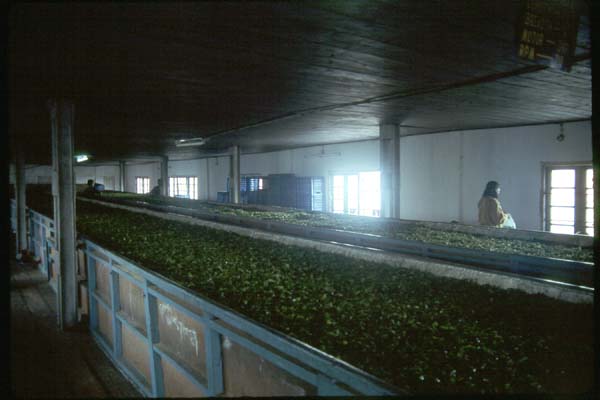
II.
Withering
"During this process, the green leaves are evenly spread on troughs,
through which hot & cold air are blown in a regulated manner. The
object is to remove moisture in the leaf slowly over a period of 14
- 16 Hours." (ibid)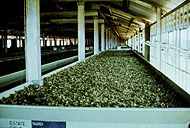
"The withered leaves are loaded into rollers where they are twisted
by a mechanical action. The process is carefully monitored so that the
style of the leaf is maintained and overheating does not take place."
(ibid)
IV. Fermentation
"After Rolling, the leaf is spread in a cool & humid room in very thin layers. The process lasts between 2- 4 hours, depending on temperature, humidity and leaf quality. During the process the tea develops a unique flavour and aroma. The Tea Makers sensory judgement is critical to quality of the liquor. (ibid)
V. Drying (Firing)
"The fermented leaf is taken to a dryer, where it is subjected to regulated varying temperature for a period of 20 - 30 min. The result is black tea whose moisture has been lost after natural fermentation is checked." (ibid)
"This is the final stage, where the tea is graded according to the size and packed in specially designed foil lined packages." (ibid)
"Darjeeling
Tea tasting is a refined art which necessarily encompasses a large number
of variables. A taster’s palate and olfactory senses are finely
sensitive and highly discriminatory. An experienced taster can identify
the garden, ambient conditions of the plucking day and can even suggest
adjustments in the manufacturing process. A taster uses his sharp sense
of sight, smell, touch and taste while judging the quality of the tea.

"A
taster must also have an in-depth knowledge about the prevailing market
conditions, consumer preferences and manufacturing techniques while
evaluating the tea. These are endowments of birth - it would be true
to say that tasters are born and not made. These natural talents, however,
have to be trained and developed through long years of practice before
the palate is proficient enough to register the minute differences.
This is particularly true for Darjeeling Tea Tasters as the quality
of tea differs from invoice to invoice and being an exclusive tea, it
has no yardstick to standardise against.
"It
is only an excellent cup that truly cheers and taste is perceptible
only by the human palate - No wonder that this craft is viewed with
a tinge of awe and wonderment. (ibid)
"Darjeeling
Tea like any world famous product, requires an efficient and reliable
marketing network to promote and sell it world wide. The Auction system
is a crucial channel in the sale of Darjeeling Tea. Since more than
50% of the produce is sold through the Calcutta Auction Centre, the
role of the Auction system can be viewed as a barometer to access the
prevailing markets.
"The
Auctioneer plays an important role. Apart from personally tasting and
evaluating each and every invoice, he has to use his knowledge of the
world demand and marketing skill in judging the marketability of the
Tea. He has final jurisdiction and his judgement determines the selling
price of the Tea, to a certain extent.
"The
Four registered Brokers, who sell the majority of Darjeeling Tea are
: J. Thomas & Co. Pvt. Ltd., Carritt Moran & Co. Ltd., Contemporary
Targett Ltd., Paramount Tea Marketing Pvt. Ltd. " (ibid)
6. Legal aspects
Indian goods which are candidates for registration as Geographic Indicators (as of May 2004)
Darjeeling tea,
Kancheepuram silks, Chanderi silk sarees, Alphonso mangoes, Basmati
rice, Kohlapuri sandals, Bikaneri Namkin, apples from Himachal and Kashmir,
Petha from Agra, Pedha from Mathura etc. (Varupi
Jain, IndiaTogether.Org, May 2004)
Tea Board of India and its intellectual properties
"All teas produced in the tea growing areas of India are administered by the Tea Board of India under the Tea Act, 1953. The Tea Board is not involved in the manufacture of any product and is run on a non-profit basis. The functions of the Tea Board are, amongst other things, to regulate the production and cultivation of Indian tea, to improve the quality of Indian tea and to improve the marketing of Indian tea within India and abroad.
"The objective of the Tea Board, under the Darjeeling Certification Trade Mark Protection Scheme, is to put in place a mechanism to ensure the supply chain integrity for DARJEELING tea so that the tea leaving the shores of India and claimed as 'DARJEELING' tea worldwide is truly a genuine Darjeeling tea. For fair and competitive marketing of Indian tea in the international markets, the Tea Board has been administering its intellectual properties (Logos) which are as under:
[The] ... "three above marks are widely known as Speciality Tea Logos of the Board indicative of the geographical origin of produce. These Speciality Tea Logos are also known as Certification Trade Marks (CTM) of the Board. The CTM Logos have been registered under Trademark Laws of various international jurisdictions. Several users of these logos are permitted by the Tea Board to use these in the course of their tea trade as marks of origin." (Tea Board of India)
What is
a certification trade mark?
"The function of trade mark is to indicate trade origin. It serves the purpose of distinguishing the goods of one trader from those of other traders. On the other hand, the purpose of a certification trade mark is to indicate that the goods on which it is impressed have been certified by some competent person in respect of some characteristic of the goods like origin, composition, mode of manufacture, or quality. The proprietor of such a mark does not himself sell or deal in the goods. Manufacturers or dealers in the goods get them certified by the proprietor of the mark and affix the mark thereon to indicate to the public that the goods have been so certified. The manufacturer or dealer may in addition to the certification trade mark affix his own trade mark on his goods. Thus an ordinary trade mark and a certification trade mark may be used side by side in relation to the same goods.
"Three considerations naturally emerge from the special nature of a certification trade mark. Firstly, it must be adapted to serve the special purpose. Secondly, the person certifying the goods as to any particular quality or characteristic or origin must be competent for the purpose. Thirdly, the use of such mark must be regulated by suitably framed rules to prevent its abuse. In the Certification Trade Mark Protection Scheme of the Tea Board all the aforesaid three considerations are fulfilled." (Tea Board of India)
Geographical indication of goods (registration & protection) Act 1999 in the post W.T.O scenario and TRIPS
"In the wake of a new international trade regime mandated by the W.T.O., it has become imperative to streamline and strengthen the existing legal procedures for administration of intellectual property rights including geographical indications in India. Under the TRIPS Agreement, there is no obligation on the part of any member state to protect any geographical indication which has fallen into disuse or ceased to be protected in its country of origin. In addition, in recognition of the mandatory international regime, Indian Parliament has passed the new law [ GI of Goods(R&P) Act, 1999] for registration and better protection of geographical indications." (Tea Board of India)
"The Act provides for the registration and better protection of GIs relating to goods. While the Act does not make provision for individual ownership, any association of persons or producers or any organization or authority representing the interest of the producers of the concerned goods can apply for registration in accordance with the provisions of Section 11 of the Act. " (IndiaTogether.Org, May 2004)
"Section
2(e) of the act defines Geographical indication in relation to goods
as agricultural goods, natural goods, manufactured goods originated
or manufactured in the territory of country or a region or locality
in that territory where a given quality reputation or other characteristic
of such goods are attributable to its geographical origin and in case
such goods are manufactured goods one of the activities of either the
production or of processing or of preparation of the goods concerned
takes place in such a place, region or locality. " (IndiaTogether.Org,
November 2001)
Darjeeling tea and the Darjeeling logo & tea board's role in administering such tea
"The district of Darjeeling is situated in the state of West Bengal, India. Since about 1835, tea has been cultivated, grown and produced in certain tea gardens geographically located in the areas within the State. Due to the unique and complex combination of agro-climatic conditions prevailing in the region and the production regulations imposed by the Tea Board, such tea has a distinctive and naturally occurring quality and flavour which has won the patronage and recognition of discerning consumers all over the world. Consequently, the tea produced in the aforesaid region and having the said special characteristics, is and has for long been known to the trade and the public in India and abroad as Darjeeling tea and as such it has acquired domestic and international reputation. Any member of the trade or public in India or abroad ordering Darjeeling tea or seeing tea advertised or offered for sale as Darjeeling will expect the tea so ordered, advertised or offered for sale to be the tea cultivated, grown and produced in the District of Darjeeling and having the aforesaid special characteristics.
"In order to make the name Darjeeling distinctive of and exclusively evocative of the district of Darjeeling, the Tea Board designed a logo which consists of the word DARJEELING and a representation of an Indian woman holding tea leaves, all arranged in a roundel. In its aesthetic combination of the word DARJEELING with the woman device, the DARJEELING logo created by the Tea Board has been a source of exclusive public recognition and identification of Darjeeling tea as a geographical indication for a uniquely flavoured tea coming from the district of Darjeeling in India. The said DARJEELING logo has been extensively used by all producers, packeteers and exporters of Darjeeling tea, under licence and authority of the Tea Board.
"Consequently, the word "Darjeeling" qualifies as a certification trade mark since it is adapted to describe tea originating in the said region in terms of its naturally inherent quality or characteristics and thus distinguish the same from other teas.
"It is in order to assist the Tea Board in its role that it has applied /registered for a Certification Trade Mark for the word DARJEELING as well as the DARJEELING logo respectively in various jurisdictions. This is because the Tea Board will be in a position to bring actions for infringement of the Certification Marks or either of them.
"The Tea Board is desirous of streamlining the procedure for a consistent and easily verifiable use of the name DARJEELING in relation to tea, in its all forms, and the DARJEELING logo (hereinafter "the Certification Trade Marks") as guarantees of Darjeeling tea. The Tea Board will license persons who wish to use the Certification Marks ("authorised users") if it is satisfied that those persons will only use the Marks in relation to tea conforming to appropriate standards and coming from the Darjeeling area. The manner of use of the Certification Marks upon or in relation to Darjeeling tea certified as such, would be determined by the Tea Board and be subject to its approval before commercial use thereof. It may be noted from Regulation 5, that there is no requirement of submission of samples with the application, but the Tea Board has the right to inspect the premises and/or call for samples of tea in respect of which the applicant/licensee is desirous of using or uses "DARJEELING" and test the sample in order to determine that the Marks are only being used or will be used in relation to genuine "DARJEELING" tea. In terms of Regulation 16, a licensee is to display on its consumer packets and/or bulk packaging material his CTM User Licence Number.
" The aforesaid certification framework is in addition to the Tea Board's already existing statutory duties and functions under the Tea Act and its various enabling Orders which govern production, marketing and export of all teas administered by the Tea Board. Such functions include the right to control or regulate the use of any label or its container which bears any false claim for such tea or is misleading in any material particular. The Tea Board shall administer the Marks "DARJEELING" as per the Regulations and various Orders issued, from time to time, under the Tea Act, 1953. " (The Tea Board of India)
Steps taken in order to protect Darjeeling tea under TRIPS
The Tea Board of India started working hard on necessary steps in 1997. Already in 1986 the Darjeeling logo was created and registered in U.K., U.S.A., Canada, Japan, Egypt and under Madrid, covering eight countries.
In 1998, World Wide Watch agency CompuMark was appointed to monitor conflicting marks. Instances of attempted registration were found, some of which were challenged through opposition and cancellations and sometimes negotiations. Of the 15 instances, 5 have been successfully concluded in countries such as Japan, Srilanka, Russia etc. 6 oppositions were unsuccessful and 4 are still pending decision Use by BULGARI, Switzerland of the legend “ Darjeeling Tea fragrance for men” agreed to be withdrawn pursuant to legal notice and negotiations.
The Tea Board has obtained “home protection” by registering a Darjeeling logo and also the word “Darjeeling” as a Certification Trade Mark under the Indian Trade and Merchandise Marks Act, 1958.
The Indian Geographical Indication of Goods (Registration & Protection) Act 1999 is a specific Act covering the registration and protection of Geographical Indications. After the Act came into force on 15th Sept.03, the Tea Board has filed an application for registration of Darjeeling tea as a “GI”.
Denton Wilde Sapte, a major U.K. law firm, appointed by the Tea Board to advise on administration of Darjeeling certification system worldwide Awareness generation at all IPR forums, WIPO conventions.
Source: Presentation by Tea Board of India, http://jpn.cec.eu.int/english/whatsnew/20040209-gi-das.pdf
India at the Doha ministerial meeting
In the run-up to the Ministerial Conference, developing countries including India had been calling extending the protection of geographical indicators to products other than wines and spirits.
"The Doha Declaration addressed their concern, but in a limited manner. While it formalized the system of protection for wines and spirits by agreeing to negotiations on the establishment of a multilateral system of notification and registration for these products, it stipulated that further study be undertaken on the issues relating to extension of GI protection to other products.
"The Council for TRIPS was to undertake this in its work programme and based on its findings, a decision would be taken at the next ministerial conference in 2003 on whether negotiations should be entered into, thus deferring the flow of benefits from such protection." (Mehra, Banerjee, Bajaj & Fernandez (Dec. 2001). India at the Doha Ministerial Meeting: An Analysis. International Journal of Regulation and Governance, 1(2): 197-214, pp. 211-212, http://www.teriin.org/online/ijrg/dec01/doha.pdf)
Current legal situation regarding protection as Geographical Indicator
Darjeeling tea is still not recognized by WTO as a Geographical Indicator. Article 23 of TRIPS gives good protection to Wines and Spirits, but currently (July 2004) not for other products.
The EU and several other countries (Bulgaria, the Czech Republic, Egypt, Hungary, India, Iceland, Liechtenstein, Mauritius, Mexico, Pakistan, Slovakia, Slovenia, Sri Lanka, Switzerland and Turkey) strugle to extend the higher level of protection provided for wines and spirits to other goods (including Darjeeling tea, Feta Cheese, etc.). The opposing countries include Argentina, Australia, Canada, Chile, Japan, New Zealand and the US.
Therefor, there is a need for either a country specific WTO dispute settlement action or campaign for extension of Article 23 protection to Indian GIs such as Darjeeling. There's also a need for co-operation and collaboration with other administrators of well known GIs (Champagne, Scotch whisky, Stilton cheese, Colombian coffee etc).
Meanwhile, protection of Darjeeling tea needs to be strengthened via the Darjeeling logo and name.
Sources:
Tea
Board, India
Increased
Marketing Opportunities for Speciality Quality Goods: Darjeeling.
UNCTAD/WTO
International Trade Center
WTO
Mandated Negotiations on Geographical Indications (TRIPS)
Update from Geneva Watch, June 12, 2003
Hundred Producers in Geneva to request protection for Geographical Indications
"We knew that some WTO Members consider protection for geographical indications for products other than wines and spirits as a crucial element in the negotiations. It is now the turn of producers to make their voice heard. On June 10-11, producers from 25 countries met in Geneva to discuss the need for better protection for geographical indications (GIs).
"During the meeting they created a new producer group called: ORIGINS: Organisation for an International Geographical Indications Network. The objectives of the group are: 1) to promote GIs as an instrument of development and protection for local knowledge; and 2) to send a strong message to the WTO negotiators in favor of better international protection for all GIs. Producers met with the WTO Deputy Director General, Mr. Francisco Thompson-Flôres and the WIPO (World Intellectual Property Organization) Deputy Director, Shozo Uemera. The Ambassador from the EC, Switzerland and India also met with the producers. The EU Trade Commissioner, Pascal Lamy spoke to the producers via telephone.
"GIs are important for producers since they use their traditional and local know-how for rural and economic development. Producers consider that currently the GIs are poorly protected which result in appropriation and exploitation of the good reputation of their products. The appropriation of the GI for a product often of lower quality, reduces the prestige and decrease prices for the original product. Producers are also losing market opporunties. For example, while 6 million pounds of “Antigua” coffee are produced in the Guatemalan region, 50 million pounds are sold under this name around the world and of the 30 million kgs of “Darjeeling” tea sold around the world, only 10 million kgs are produced in India.
"Attending the meeting, the EC Ambassador, Carlo Trojan, told the
press that there would be no deal on agriculture without an agreement
on geographical indications. He told the producers that the European
Community fully supports the objectives of their initiative. He also
said: “I have heard that geographical indications would be an
expression of protectionism. The idea is completely unfounded. The protection
of geographical indications is not about protectionism but about free
trade.”" (Geneva
Watch Weekly (June 12, 2003). An overview of the WTO negotiations
on agriculture. Emphases added)
A Summation of the National Symposium on Trade and Globalization Conducted in New Delhi, India on 18 –19 August 2003.
"A National Symposium on Trade and Globalization was jointly organized by the Government of India (GOI) , United Nations Development Programme (UNDP) and United Nations Conference on Trade and Development (UNCTAD) on 18-19 August 2003 at New Delhi. The objective of the Symposium was to enable the GOI to consult with its stakeholders before the 5th World Trade Organisation (WTO) Ministerial Conference in Cancun, Mexico. It was also an opportunity to have objective, focused and informed discussions on the issues on the Doha work programme. Around 150 participants from the Government, NGOs, think-tanks, academia, private sector and law firms attended this symposium. International experts from different parts of the world also shared their views.
"The symposium was inaugurated by Honourable Union Minister of Commerce and Industry, Government of India, Mr Arun Jaitley. Ms Lakshmi Puri, Director, Trade Division, UNCTAD and Mr Maurice Dewulf, Acting Resident Representative, UNDP also spoke on the occasion providing their perspectives. The GOI made available its negotiating team, comprising inter alia of Mr Dipak Chatterjee, Secretary, Ministry of Commerce and Industry to interact with the stakeholders." (p. 1)
"On geographical indications (GIs), Article 22 (protection of GIs), Article 23 (additional protection in respect of wines and spirits; negotiations for establishment of multilateral registry) and Article 24 (certain exceptions) continue to be the focus of further deliberations. While India’s position was to extend the GI beyond wines and spirits the participants felt that further study was needed on the commercial benefits of GIs for India. "(p. 7)
Source:
Government of India, UNDP, UNCTAD
http://www.smenetwork.net/wto/uncad.pdf
See also "tea & coffee trade online", Volume 172, No. 6, June/July, 2000
Discourse
and Status: Disagreement and incomplete
Forum and Scope: India and unilateral
Decision Breadth: India
Legal Standing: Treaty
7. Geography
6.1
Geographic Location
a. Geographic Domain: South-Eastern slopes
of Himalaya, Asia
b. Geographic Site: South Asia
c. Geographic Impact: India
Sub National Factors: Yes. Darjeeling, India.
Type of Habitat: Temperate. Villages on high hills.
8. Trade
The tea trade in India is one of the largest contributors to the country's economy.
Surprised?
But, naturally, being the world's single largest producer of tea (an estimated in 870 million kgs, was produced in 1998!) requires a large network of tea producers, retailers, distributors, auctioneers, exporters, packers, etc. and playing these roles, from the gardens to the stores, is one of the largest workforces in the country.
Being home to the world's best teas, it is no surprise that India is also one of the world's largest exporters of tea. And this is no mean feat, as the figures prove. Almost every tea-drinking nation in the world imports some variety of Indian tea!
Some of the premium varieties available throughout the world are inevitably Indian (many from the gardens of Darjeeling), apart from the value-added Tea Bags and Instant Tea which are a hugely popular in the West, especially in countries such as the USA. In 1997, India exported an estimated 203 million kgs of tea all over the world.
Source: India Tea National Information Center, page on Tea Economics
Below
graph prepared by Gadi Kenny
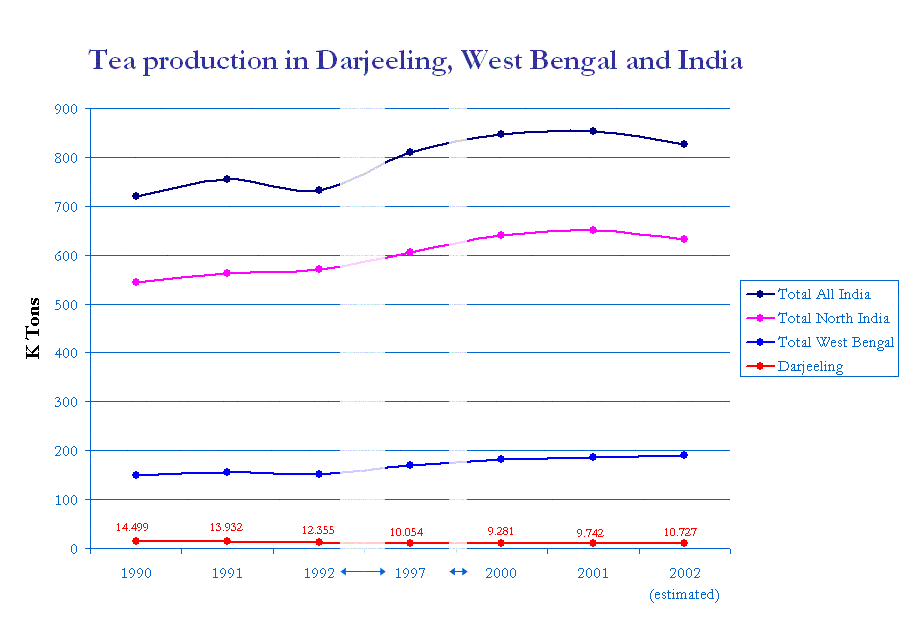
Type of Measure: Intellectual Property
Direct v. Indirect Impacts: Indirect
Relation of Trade Measure to Environmental Impact
a. Directly Related to Product: Yes,
Darjeeling Tea
b. Indirectly Related to Product: No, Tea plantations
c. Not Related to Product: No, None
d. Related to Process: Yes, Culture
Trade Product Identification: Darjeeling, Pure Darjeeling, 100% Darjeeling
Economic Data
Impact of Trade Restriction: Low
Industry Sector: Food
Exporters and Importers: India and Many, especially Britain, United States
9. Environment
Mark
Twain said of Darjeeling:
"The
one land that all men desire to see, and having seen once by even a
glimpse
would not give that glimpse for the shows of the rest of the world combined."
Panoramic
view from Tiger Hill with Kanchenjunga range (right) and
a glimpse of Mount Everest (left) with Darjeeling town in the foreground
Environmental Problem Type: Culture
Name,
Type, and Diversity of Species
Name: Darjeeling Tea
Diversity: Low
Resource Impact and Effect: High and Product
Urgency and Lifetime: Low and 150 years
Substitutes: Like Products
10. Culture
Languages spoken in Darjeeling town: English, Nepali, Hindi, Tibetan and Bengali.
Darjeeling
as a form of life to local population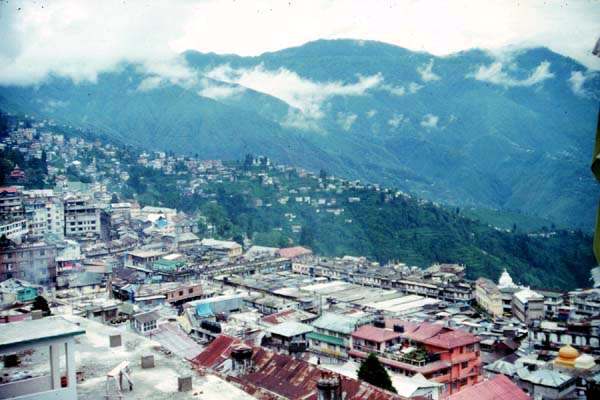
"The income of a garden worker is half in the form of cash and the other half by way of perquisites which have over the years effectively provided a cushion against the impact of inflation and scarcities, for example, the workers are provided with free accommodation, subsidised cereal ration and free medical benefits. Gardens used to run primary schools which have since been taken over by the government but the buildings continue to be maintained by the garden management.
"According to the census carried out in the hills in 1971, the total population of three hill sub-divisions of district viz. Darjeeling, Kurseong and Kalimpong was approximately 600,000. From the records maintained by the tea gardens, the resident population is over 300,000.
"Apart from tourism, Tea is the biggest industrial activity, offering the largest employment in the hills. The turnover of the Darjeeling tea industry is nearly USD 7.5 million, which is acknowledged to be more than the money generated by tourism in the Darjeeling hills.
"Apart from the direct production and employment figures mentioned above, a large segment of the population earn their livelihood from the peripheral sector of the industry. This consists of transport, supplies, repair, establishment etc." (The Darjeeling Planters Association)
Peoples of the region
The
Lepchas or Rongpas
"Known as the 'squatters', these kindly 'ravine people' the inhabitants
of Sikkim are of Mongolian origin and have been supplanted by the virile
Nepalese through inter-marriage. The Lepchas have lost their literature
and have suffered by the constant ravages of the marauding neighboring
hills tribes. Their white complexion, tinged with yellow, the women
have graceful features and wear heavy ear-rings and necklaces studded
with turquoise and coral. They do all the household and farm work, besides
caring for the cattle and poultry. Peace-loving and carefree the short
but broad-chested and sinewy men, the strong arms, find non-violent
uses for the long knife they are want to carry. Flowing hair woven into
plaited pigtails tops their graceful dress, reminiscent of the Roman
gladiators. The Khampas, another branch of the Lepchas, are warrior-like
and more dashing than their docile cousins. Both branches are Buddhists
and under the influence of their priests. The Khampas are recent immigrants
from Tibet.
The
Nepalese
"Immigrants from Nepal, they are the dominant people and are divided
into different castes, speaking various dialects. The short Mongolian
type Nepalese, the Gorkhas, renowned for their military prowess the
world over, and the first to be decorated with the coveted Victoria
Cross, finds jobs and security both in the British and Indian armies.
Powerfully built, exploits of the Gorkha Rifles have gone down into
legend literature and lore. They carry the traditional weapon, the Khukri-a
curved ornamental knife put to every conceivable use. Other with aquiline
noses, broad foreheads, large eyes and tall stature are of Aryan stock
and descended from the Rajput refugees who fled India at various stages
of her turbulent history. They brought with them, Hinduism. There are
also the Gurungs, Magars, Rais, Tamangs and Newars from west Nepal.
The Magars are also sub-divided into the Ranas, Thapas and Ales.
The
Newars
"Newars are the original inhabitants of the Nepal Valley possessing
their own language, script and literature. Besides being good painters,
they are also wood-carvers, sculptors and metal workers. Best known,
however, the world over-the Sherpas, originally from Solo Khumbu, plucky
mountaineers who won undying fame after the conquest of Everest by Sherpa
Tenzing Norgay. Said the London Times of Tenzing, inhabitant of Namche
Bazaar, "...He is obviously and indisputably one of Nature's gentlemen.
He has an inborn ease and elegance that would cause a flutter in many
a London drawing-room ...... In spite of his international fame, and
although before the final assault, he had climbed higher than any of
the Europeans of expedition, he retained his modesty throughout, and
was as willing to help in the menial tasks of camp life as to share
the fiercest dangers of Everest's summit". The eloquent tribute
can relatively apply, in parts, to all the gallant Sherpas. Tenzing
Norgay is no more with us but world will remember till the end of this
earth. In the memory of this hero of Everest Central Bus Terminus at
Siliguri has been named as Tenzing Norgay Bus Terminus and Hill Cart
Road linking Darjeeling with Siliguri has been renamed as Tenzing Norgay
Road.
The
Bhutias
"The Bhutias are divided into Tibetan, Bhutan, Dharma and Sikkim
Bhutias. The Sikkim Bhutias or Arrats wear flowing robes and ornamental
long knives. They form a large part of population and, among them, are
the Mechis who are original tribes from the Terrai region. The Limbus,
a hardy people, are migrants from Nepal, but more Mongolian and under
the influence of their priests, largely during birth, marriage or death.
Simple and good natured, music and dance forms an integral part of their
life. They are rooted to the soul. " (Zubin.com (1999-2002). Darjeeling,
the land and the people)
Culture: Yes
Trans-Boundary Issues: No
Rights: No
11. Related cases
| Product (alphabetically) |
Main states or regions involved | Site's title |
| Czech, USA | Who Owns the Name Budweiser? | |
| Brazil, South America | Brazilian Fire Water | |
| Canada, USA | Canadian Whiskey and Protection as a Geographic Indication | |
| France and Germany | Cassis Spirit Trading | |
| EU | EU's Chocolate Dispute | |
| France | The Elixir of the Gods | |
| Greece, EU | Feta Cheese | |
| Germany | German Beer Purity Law | |
| EU, Italy, South Africa | Who Owns Grappa | |
| Haiti, USA | Trade and the Disappearance of Haitan Rice | |
| USA | Kentucky Bourbon and Protection as a Geographic Indication | |
| Mexico | Mezcal and Protection as a Geographic Indication | |
| Ouzo | Greece, South Africa | Ouzo, Trade and Culture |
| Chile, Peru | Pisco Liquor Dispute between Chile and Peru | |
| Poland, EU | Zubrowka: Polish Vodka and Cultural Georaphic Indicators | |
| Britain, Scotland | The Culture of the World's Leading Spirit | |
| USA | Tennesse Whiskey and Protection as a Geogrpahic Indication | |
| Mexico, China | Tequila: Trade, Culture, and Environment |
12. Links to commercial sites that offer "Darjeeling tea"
Note: This list certainly does not instititute any kind of recommendation. It is presented for demonstration purposes only.
13. Bibliography
European Commission (Aug. 28, 2003). WTO talks: EU steps up bid for better protection of regional quality products. IP/03/1178. Brussels. www.ictsd.org/ministerial/cancun/docs/EC_GIs.pdf
European Commission (July 30, 2003). Intellectual Property: Why Geographical Indications matter to us? Brussels. http://europa.eu.int/comm/trade/issues/sectoral/intell_property/argu_en.htm
European Commission
(Sept. 2003). Trade
Barriers Regulation: What is TBR?. Brussels.
http://europa.eu.int/comm/trade/issues/respectrules/tbr/index_en.htm
Geneva Watch. An overview of the WTO negotiations on agriculture (June 12, 2003). (Magazine) Geneva.www.chicken.ca/Geneva/v3n20_12-6-2003_en.pdf
Government of India, United Nations Development Program (UNDP), United National Conference on Trade and Development (UNCTAD) (August 2003). What is at stake at Cancun and beyond for India? A Summation of the National Symposium on Trade and Globalization. New Delhi. www.smenetwork.net/wto/uncad.pdf
Graafsma, Folkert & Alves, Sofia (1997). International Trade Developments, Including Commercial Defence Actions XIII: 1 January 1997 – 31 June 1997. http://www.ejil.org/journal/Vol9/No2/sr1.rtf
Mehra, M.K., Banerjee, S., Bajaj, R. & Fernandez, C. (?). India at the Doha ministerial meeting: an analysis. (Review article). International Journal of Regulation and Governance 1(2): 197-214. New Delhi. www.teriin.org/online/ijrg/dec01/doha.pdf
Rangnekar, Dwijen (March 2003). Protecting Geographical Indications. What developing countries need to do - lessons from the EU experience. (Seminar Presentation at UNU/INTECH, Maastricht, 26 March, 2003). www.intech.unu.edu/events/ seminar-series/2003-2-spknotes.pdf
Rangnekar, Dwijen (Oct. 2003). The Socio-Economics of Geographical Indications: A Review of Empirical Evidence from Europe. UNSTAD/ICTSD Capacity building project on Intelectual Property Rights and Sustainable Development. Coventry. www.iprsonline.org/unctadictsd/docs/order_form_web.pdf
Tea Board, India (2004?). Increased Marketing Opportunities for Speciality Quality Goods: Darjeeling. http://jpn.cec.eu.int/english/whatsnew/20040209-gi-das.pdf
UNCTAD/WTO International Trade Center().WTO Mandated Negotiations on Geographical Indications (TRIPS). http://www.intracen.org/worldtradenet/ docs/information/referencemat/tripsg1.pdf
World Trade Organization (1994). Article 23 of the Agreement of Trade Related Aspects of Intellectual Property (TRIPS) of the World Trade Organization (WTO). http://www.wto.org/english/docs_e/legal_e/27-trips_04b_e.htm
14. Links to Darjeeling tea, region, train and tourism
"If
you are cold,
tea will warm you.
If you are heated, it
will cool you.
If you are depressed,
it will cheer you.
If you are excited, it
will calm you."
-- William Gladstone
This case study compiled by Gadi Kenny (Israel)
MA Candidate, International Communication, School of International Service
(SIS)
sk2356a@american.edu

